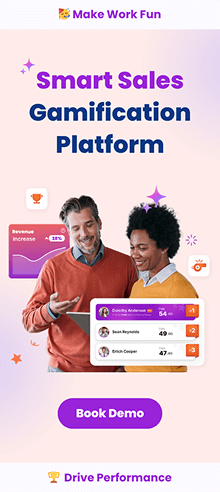Struggling to keep your team on task during the week? Are you searching for an innovative way to help them reach their goals and improve their team-building skills?
No matter what you want to achieve, gamification is one of the most powerful strategies you can use to increase engagement and motivation.
Gamification is the process of incorporating game elements into a non-game context. With this strategy, businesses can use the same tools that video games and gamified customer loyalty programs use to keep their team engaged. However, it’s important to remember that there are a few ground rules for gamification. You can’t just turn everything into a game and hope to see a change in the workplace.
We’re here to walk you through the rules of gamification, so you can start taking advantage of this strategy in your work week.
Here’s everything you need to know:
The Benefits of Gamification

There are many benefits of incorporating gamification into the workplace, especially when it comes to increasing productivity and keeping company morale high. Many of the most common benefits include:
- Increased Engagement: Studies suggest gamification can increase employee motivation by over 48%. With the right game elements, you can turn everyday tasks into fun-filled activities for your team.
- Improved Collaboration: Gamification brings people together. This complex strategy complements your team-building initiatives and helps you build a thriving company culture. With the right game elements, games, and resources, leaders can inspire collaboration and friendly competition among coworkers while improving the experience for everyone.
- Increase Productivity: In a recent survey by Zippa, over 90% of survey takers said gamification increased their productivity in the workplace. Inviting gamification into the workplace can help your team adjust their approach to everyday tasks, projects, and activities. This will improve productivity and efficiency, leading to more revenue over time.
The 10 Rules of Gamification
If you decide to incorporate gamification into the workplace, there are a few things you’ll need to keep in mind. You can’t just start manually tracking your team’s success or planning mini-sales games yourself and hope it works. A ton goes into finding success with gamification, and there are guidelines to consider.
These rules and guidelines will ensure you successfully incorporate gamified tactics into the workplace and get the most from strategy.
Here are the 10 rules of gamification you’ll need to know:
Rule 1: You Aren’t Creating Games. You’re Using the Game Elements
This is one of the biggest misconceptions of gamification. Many companies believe this strategy is about getting creative and thinking about different games they can plan for their team. However, gamification is about infusing game elements into the workplace. It challenges your team to rethink their approach to everyday tasks, pushing them to be more productive and efficient during the workweek.
While games and mini-competitions are a big part of the process, they are only one piece of the puzzle. To see results with gamification, you’ll need to pair the games with recognition initiatives, rewards, incentives, and innovative sales coaching lessons.
Spinify is a sales gamification software that uses various game elements in the workplace. You can choose which tactics best serve your team’s needs, developing a personalized, gamified approach specific to your team’s needs.
Rule 2: Don’t Just Plan. Set Goals.
You want to set goals for your gamification strategy, not just your employees. While your employee’s success should always be top of mind, you always want to ensure your gamified initiatives deliver rules. Goals will keep your team on task and help you fine-tune your approach to gamification. These goals help you keep your leadership on task and your employees inspired.
Some great goals to consider include:
- An X% increase in productivity
- X% increase in efficiency
- Increase in revenue, closed deals, or booked demos
- A reduction in employee turnover
Set goals that align with your company’s goals. Every month you can reference these goals later to ensure you’re on task.
Rule 3: Not Every Problem Can Be Solved With Gamification
While gamification can improve the workplace experience, it’s not the key to all workplace problems. If you’re struggling with company morale, motivation, or underperforming, there are other adjustments you’ll need to make. You’ll also want to make sure you’re:
- Scheduling weekly sales coaching sessions
- Providing access to productivity tools and resources
- Consider providing resources for task management and sales strategies
- Make sure your team has the support they need to reach their goals
- Send out check-in surveys and schedule weekly 1:1s with your team
- Personalize your approach to the sales process for every team member
Rule 4: Gamification is About More Than Friendly Competition
‘Friendly competition is a great motivation booster that can keep your team productive, entertained, and efficient between 9-5. However, games, contests, and mini-games are just one part of the strategy. Other game elements you’ll want to consider are badges, leaderboards, and progress bars to track your team’s success and celebrate their contributions.
Rulle 5: You Can Use More Than One Game Element At Once
Gamification works best when it’s fully integrated into everything you do. That means you’ll want to do more than plan a few monthly competitions and games. Consider how to use gamification during 1:1s, weekly meetings, and day-to-day activities. While you may think using more than one game element at once is overwhelming, it’s a great way to familiarize your team with the strategy.
Rule 6: Gamification Isn’t Just For Your Sales Team
Contrary to belief, gamification can keep your entire team engaged, not just your sales. This means individuals in your IT, customer service, or even marketing department can join in on the fun and experience the benefits of gamification for themselves.
If you use gamification to keep other departments engaged, you’ll want to adjust your approach to align with their goals and needs. This is the best way to maximize your results and ensure everyone is engaged and entertained with the game elements you choose to use.
Rule 7: Focus on Retention, Not Just Sales
If your gamification efforts are always focused on bringing in new business, you’ll never see the results you need to scale your business. In fact, it’s expected that returning customers spend an average of 33% more than a one-time purchaser. When planning mini-games and contests for your sales team, consider how to include renewals and customer retention in the mix. This will help strengthen your sales pipeline and help you improve your relationship with your current customers.
Rule 8: Gamification Isn’t Just Points on a Leaderboard
Adding points to a leaderboard and handing out rewards here and there may help increase engagement, but it won’t deliver the results you deserve. For gamification to work, you need to dig deeper. Ask your team:
- What motivates you?
- What rewards and incentives do you want to see more of?
- Are you inspired by friendly competition or your own success?
- How can leadership or your manager help?
With these questions, you can fine-tune your approach to the workplace as a whole and integrate gamification into the everyday experience.
Rule 9: Always Add Value to The Experience
If the focus is always on the rewards and incentives your team will receive if they snag one of the top slots on the leaderboard, they’ll lose sight of the true purpose. Your team should be focused on growing professionally. They should use gamification as motivation to push themselves towards success.
A great way to remind your team members to not lose track of the purpose is to check in with them during weekly 1:1s and sales coaching sessions. During these moments, you can use performance grids and other tools to help restructure their approach to sales and help them improve their strategy.
Rule 10: Gamification is For Leadership, too. Not Just Your Team
While our team may benefit the most from your gamification initiatives, they aren’t the only ones who can use these tools. Your leadership and sales managers can also benefit from gamification. Whether it’s with automated tools, performance grids, or interactive elements that can improve their sales coaching.
At Spinify, we have a manager tool kit your leadership team can use to enhance their approach to sales coaching. The tool includes:
- Notes
- Tasks
- Performance Grids
- Leadership Graphs
- Spinify Score Cards
Each of these tools can help your managers personalize their approach to sales coaching to ensure each team member is fully experiencing the benefits that come with the game elements you choose to incorporate into the workplace.
Gamify The Workplace With Spinify
If you want to find success with gamification, you need to adjust your approach to meet the needs of your team and company. These rules are set in place not to take away from the experience but to ensure your employees benefit from the different game elements you incorporate into the workplace.
Spinify is a sales gamification software designed with you in mind. We use many different game elements to help increase productivity and keep your team on task during the work week. Whether it’s rewards, games, or leaderboards – we’re here to help you fine-tune your approach to gamification.



